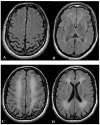Delayed Neurological Sequelae Successfully Treated with Adjuvant, Prolonged Hyperbaric Oxygen Therapy: Review and Case Report
- PMID: 35564694
- PMCID: PMC9104642
- DOI: 10.3390/ijerph19095300
Delayed Neurological Sequelae Successfully Treated with Adjuvant, Prolonged Hyperbaric Oxygen Therapy: Review and Case Report
Abstract
Carbon Monoxide (CO) intoxication is still a leading cause of mortality and morbidity in many countries. Due to the problematic detection in the environment and subtle symptoms, CO intoxication usually goes unrecognized, and both normobaric and hyperbaric oxygen (HBO) treatments are frequently administered with delay. Current knowledge is mainly focused on acute intoxication, while Delayed Neurological Sequelae (DNS) are neglected, especially their treatment. This work details the cases of two patients presenting a few weeks after CO intoxication with severe neurological impairment and a characteristic diffused demyelination at the brain magnetic resonance imaging, posing the diagnosis of DNS. After prolonged treatment with hyperbaric oxygen, combined with intravenous corticosteroids and rehabilitation, the clinical and radiological features of DNS disappeared, and the patients' neurological status returned to normal. Such rare cases should reinforce a thorough clinical follow-up for CO intoxication victims and promote high-quality studies.
Keywords: carbon monoxide; delayed neurologic sequelae; hyperbaric oxygen; hyperbaric oxygen therapy; intoxication; poisoning.
Conflict of interest statement
The authors declare no conflict of interest.
Figures



Similar articles
-
The occurrence of delayed neuropsychologic sequelae in acute carbon monoxide poisoning patients after treatment with hyperbaric or normobaric oxygen therapy.Medicine (Baltimore). 2021 Jan 15;100(2):e24183. doi: 10.1097/MD.0000000000024183. Medicine (Baltimore). 2021. PMID: 33466193 Free PMC article.
-
Neurocognitive sequelae after carbon monoxide poisoning and hyperbaric oxygen therapy.Med Gas Res. 2020 Jan-Mar;10(1):30-36. doi: 10.4103/2045-9912.279981. Med Gas Res. 2020. PMID: 32189667 Free PMC article. Review.
-
Delayed neuropsychologic sequelae after carbon monoxide poisoning: prevention by treatment with hyperbaric oxygen.Ann Emerg Med. 1995 Apr;25(4):474-80. doi: 10.1016/s0196-0644(95)70261-x. Ann Emerg Med. 1995. PMID: 7710151 Clinical Trial.
-
Targeting optimal time for hyperbaric oxygen therapy following carbon monoxide poisoning for prevention of delayed neuropsychiatric sequelae: A retrospective study.J Neurol Sci. 2019 Jan 15;396:187-192. doi: 10.1016/j.jns.2018.11.025. Epub 2018 Nov 22. J Neurol Sci. 2019. PMID: 30481656
-
Hyperbaric or normobaric oxygen for acute carbon monoxide poisoning: a randomised controlled clinical trial.Med J Aust. 1999 Mar 1;170(5):203-10. doi: 10.5694/j.1326-5377.1999.tb140318.x. Med J Aust. 1999. PMID: 10092916 Review.
Cited by
-
Serum neurofilament light chain for predicting delayed neurological sequelae after acute carbon monoxide poisoning.Acta Neurol Belg. 2024 Feb;124(1):73-79. doi: 10.1007/s13760-023-02334-7. Epub 2023 Jul 19. Acta Neurol Belg. 2024. PMID: 37468802
-
Hyperbaric oxygen treatment in delayed post-hypoxic encephalopathy following inhalation of liquefied petroleum gas: a case report.Diving Hyperb Med. 2023 Dec 20;53(4):351-355. doi: 10.28920/dhm53.4.351-355. Diving Hyperb Med. 2023. PMID: 38091596 Free PMC article.
-
Editorial: Carbon monoxide poisoning: updates on prevention, diagnosis, and treatment.Front Med (Lausanne). 2024 Apr 16;11:1411547. doi: 10.3389/fmed.2024.1411547. eCollection 2024. Front Med (Lausanne). 2024. PMID: 38690173 Free PMC article. No abstract available.
-
Hyperbaric oxygen for the treatment of carbon monoxide-induced delayed neurological sequelae: a case report and review of the literature.Diving Hyperb Med. 2024 Mar 31;54(1):65-68. doi: 10.28920/dhm54.1.65-68. Diving Hyperb Med. 2024. PMID: 38507912 Free PMC article. Review.
-
Case report: Consecutive hyperbaric oxygen therapy for delayed post-hypoxic leukoencephalopathy resulting from CHANTER syndrome caused by opioid intoxication.Front Med (Lausanne). 2024 Apr 17;11:1364038. doi: 10.3389/fmed.2024.1364038. eCollection 2024. Front Med (Lausanne). 2024. PMID: 38695031 Free PMC article.
References
-
- Hampson N.B., Weaver L.K. Carbon Monoxide Poisoning: A New Incidence for an Old Disease. Undersea Hyperb. Med. 2007;34:163–168. - PubMed
Publication types
MeSH terms
Substances
LinkOut - more resources
Full Text Sources
Medical

